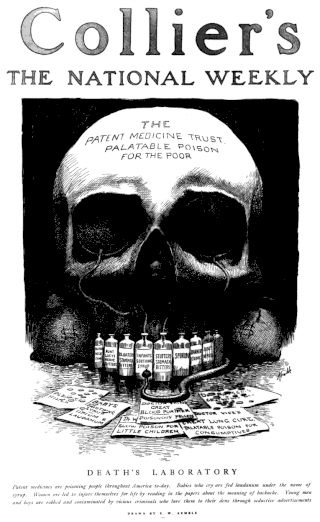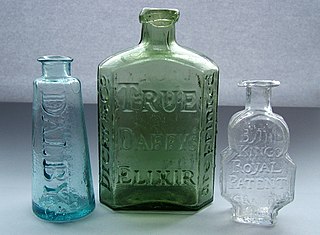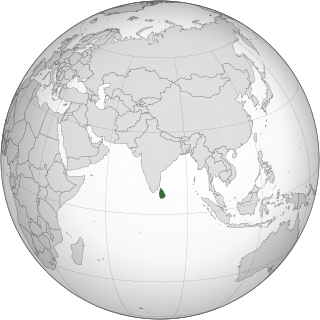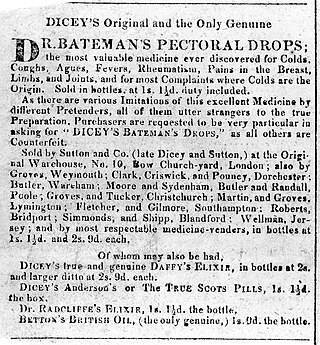
The Harrison Narcotics Tax Act was a United States federal law that regulated and taxed the production, importation, and distribution of opiates and coca products. The act was proposed by Representative Francis Burton Harrison of New York and was approved on December 17, 1914.

Opium is dried latex obtained from the seed capsules of the opium poppy Papaver somniferum. Approximately 12 percent of opium is made up of the analgesic alkaloid morphine, which is processed chemically to produce heroin and other synthetic opioids for medicinal use and for the illegal drug trade. The latex also contains the closely related opiates codeine and thebaine, and non-analgesic alkaloids such as papaverine and noscapine. The traditional, labor-intensive method of obtaining the latex is to scratch ("score") the immature seed pods (fruits) by hand; the latex leaks out and dries to a sticky yellowish residue that is later scraped off and dehydrated.

Laudanum is a tincture of opium containing approximately 10% powdered opium by weight. Laudanum is prepared by dissolving extracts from the opium poppy in alcohol (ethanol).

Paregoric, or camphorated tincture of opium, also known as tinctura opii camphorata, is a traditional patent medicine known for its antidiarrheal, antitussive, and analgesic properties.

A potion is a liquid "that contains medicine, poison, or something that is supposed to have magic powers." It derives from the Latin word potio which refers to a drink or the act of drinking. The term philtre is also used, often specifically for a love potion, a potion that is supposed to create feelings of love or attraction in the one who drinks it. Throughout history there have been several types of potions for a range of purposes. Reasons for taking potions ranged from curing an illness, to securing immortality to trying to induce love. These potions, while often ineffective or poisonous, occasionally had some degree of medicinal success depending on what they sought to fix and the type and amount of ingredients used. Some popular ingredients used in potions across history include Spanish fly, nightshade plants, cannabis, and opium.

A patent medicine is a non-prescription medicine or medicinal preparation that is typically protected and advertised by a trademark and trade name, and claimed to be effective against minor disorders and symptoms, as opposed to a prescription drug that could be obtained only through a pharmacist, usually with a doctor's prescription, and whose composition was openly disclosed. Many over-the-counter medicines were once ethical drugs obtainable only by prescription, and thus are not patent medicines.

A drug overdose is the ingestion or application of a drug or other substance in quantities much greater than are recommended. Typically it is used for cases when a risk to health will potentially result. An overdose may result in a toxic state or death.
Lactucarium is the milky fluid secreted by several species of lettuce, especially Lactuca virosa, usually from the base of the stems. It is known as lettuce opium because of its sedative and analgesic properties. It has also been reported to promote a mild sensation of euphoria. Because it is a latex, lactucarium physically resembles opium, in that it is excreted as a white fluid and can be reduced to a thick smokable solid.

Chlorodyne was one of the best known patent medicines sold in the British Isles. It was invented in the 19th century by a Dr. John Collis Browne, a doctor in the British Indian Army; its original purpose was in the treatment of cholera. Browne sold his formula to the pharmacist John Thistlewood Davenport, who advertised it widely, as a treatment for cholera, diarrhea, insomnia, neuralgia, migraines, etc. As its principal ingredients were a mixture of laudanum, tincture of cannabis, and chloroform, it readily lived up to its claims of relieving pain, as a sedative, and for the treatment of diarrhea.

Dalby's Carminative was one of the two most widely used patent medicines given to babies and children at the end of the 18th and beginning of the 19th centuries. Together with its rival, Godfrey's Cordial, they were known as "mother's friends" and were used for everything from colic and coughs to typhoid.

Mithridate, also known as mithridatium, mithridatum, or mithridaticum, is a semi-mythical remedy with as many as 65 ingredients, used as an antidote for poisoning, and said to have been created by Mithridates VI Eupator of Pontus in the 1st century BC. It was one of the most complex and highly sought-after drugs during the Middle Ages and the Renaissance, particularly in Italy and France, where it was in continual use for centuries. An updated recipe called theriac was known well into the 19th century.

Codeine is an opiate and prodrug of morphine mainly used to treat pain, coughing, and diarrhea. It is also commonly used as a recreational drug. It is found naturally in the sap of the opium poppy, Papaver somniferum. It is typically used to treat mild to moderate degrees of pain. Greater benefit may occur when combined with paracetamol (acetaminophen) or a nonsteroidal anti-inflammatory drug (NSAID) such as aspirin or ibuprofen. Evidence does not support its use for acute cough suppression in children. In Europe, it is not recommended as a cough medicine in those under 12 years of age. It is generally taken by mouth. It typically starts working after half an hour, with maximum effect at two hours. Its effects last for about four to six hours. Codeine exhibits abuse potential similar to other opioid medications, including a risk of habituation and overdose.

Hydromorphinol, is an opiate analogue that is a derivative of morphine, where the 14-position has been hydroxylated and the 7,8- double bond saturated. It has similar effects to morphine such as sedation, analgesia and respiratory depression, but is twice as potent as morphine and has a steeper dose-response curve and longer half-life. It is used in medicine as the bitartrate salt and hydrochloride
Warburg's tincture was a pharmaceutical drug, now obsolete. It was invented in 1834 by Dr. Carl Warburg.
Opium and Romanticism are well-connected subjects, as readers of Romantic poetry often come into contact with literary criticisms about the influence of opium on its works. The idea that opium has had a direct effect on works of romantic poetry is still under debate; however, the literary criticism that has emerged throughout the years suggests very compelling ideas about opium and its impact on Romantic texts. Usually these criticisms tend to focus on poets such as Samuel Taylor Coleridge, Thomas De Quincey and George Crabbe.

The history of pharmacy as a modern and independent science dates back to the first third of the 19th century. Before then, pharmacy evolved from antiquity as part of medicine. The history of pharmacy coincides well with the history of medicine, but it's important that there is a distinction between the two topics. Pharmaceuticals is one of the most-researched fields in the academic industry, but the history surrounding that particular topic is sparse compared to the impact its made world-wide. Before the advent of pharmacists, there existed apothecaries that worked alongside priests and physicians in regard to patient care.

Cannabis in Sri Lanka is legally sold through Ayurveda herbal shops, and can be used for medical and scientific purposes if given a license by the Ministry of Health. For recreational usage cannabis is not legal. However, cannabis plays a major role in the traditional culture of the island, with the specific Sinhalese or Sanskrit names virapati (“hero-leaved”), capta (“light-hearted”), ananda (“bliss”), trilok kamaya and harshini indicating its various properties, such as inducing euphoria and heightening sexual energy.

The Anti-Heroin Act of 1924 is a United States federal law prohibiting the importation and possession of opium for the chemical synthesis of an addictive narcotic known as diamorphine or heroin. The Act of Congress amended the Smoking Opium Exclusion Act of 1909 which authorized the importation of the poppy plant for medicinal purposes utilizing an opium pipe or vaporization to consume the euphoric opiate.

Dr Bateman's Pectoral Drops was a popular patent medicine for disorders of the chest or lungs during the 18th, 19th, and early 20th centuries in Britain and North America. It was later marketed as a remedy for ‘all Rheumatic and Chronic complaints, in pains of the limbs, bones, and joints, for influenza, and in violent colds,.
















